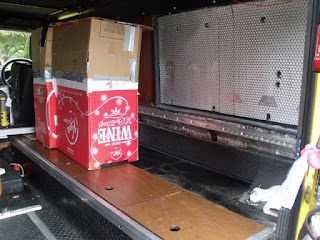Now that the background work is complete down one side of the truck, it's time to start on the more interesting stuff.
However, before I got to grips with more challenges inside, I had another look at the Masai windows. Their suggestion regarding a DIY repair didn't mention that the bare metal would have to be etch primed to give the new paint any chance of adhering. Without primer the topcoat would flake off quicker than a leper's lips so possibly the etch primer wasn't applied to the frame to begin with, hence the problem. Anyway, I've followed their instructions to the letter on the OS window and we'll see how long this "repair" lasts. The NS window I've done my way. They haven't bothered to respond to my whinge about their answer and "solution". Will I buy anything else from them....?
Back inside. We explored the best arrangement for the fixtures a while ago, and decided that to get decent - read "barely possible" - access to the storage bins the fridge would have to be on sliders. This would also allow it to be moved to the centre aisle for La Chef to get easier access; the benefit here would be it could be opened fully without having to tip the driver's seat forwards, and could provide extra worktop space closer to the hob. Sliding it back to the OS is necessary when on the move otherwise it blocks the view through the blindspot window.
 |
| The runners clear the Wolf box so this storage- and the single bed base - still works although I'll have to sleep the other way round with my feet at the front end. |
 I had a pair of heavy duty slides that had originally been used to mount video projectors. These can take serious loads but are really lightweight and superbly engineered. I spent the whole day fiddling about with these and eventually had them mounted so that they were level, square and solidly fixed to the truck bed.
I had a pair of heavy duty slides that had originally been used to mount video projectors. These can take serious loads but are really lightweight and superbly engineered. I spent the whole day fiddling about with these and eventually had them mounted so that they were level, square and solidly fixed to the truck bed. I was very pleased with the result...until I mounted the (empty) fridge on top. Given the restricted access since we can't get in front of it to pull it out the fridge didn't want to slide very easily at all. It worked, but only just and bearing in mind this was without the top extension or anything in it, I was forced to admit that it didn't work well enough.
The problem, I think, is the Delrin lining to the slider mounts just doesn't have the necessary "slipperiness" to work in the way we need despite plenty of silicone lube. A wasted day, going in circles trying to get everything to work and ultimately failing, but better to admit it now rather than having to do it again later when other stuff will be in the way, like the new seats.
I contacted Exmoor Trim to see if they could replicate the seat I already have. They asked me to send a photo. That was over a week ago and no response. Maybe it's me? Harrumph!
 Little bits'n pieces...blind spot mirrors - the little 50mm ones - stuck to the door mirrors, which give an improved view that's altogether safer than before.
Little bits'n pieces...blind spot mirrors - the little 50mm ones - stuck to the door mirrors, which give an improved view that's altogether safer than before.Then there's the net pocket on the passenger side, at the special request of the Navigator,
that holds water bottles and tea flasks and stops them rolling around and annoying the Driver every time we turn a corner!!!
The CB radio is re-installed in the very handy overhead tray that comes with the Alu-Cab roof. There's also plenty of storage up there for maps and guidebooks too, although they'll probably need some kind of restraint given our experience with my DIY version. Getting showered with books on every steep upslope became a bit predictable. We removed the handle from underneath the "ceiling" too - it was just low enough to whack us on the head if the roof is down.
After a few more "ups and downs" with the roof we've worked out that if it's pulled down too quickly the air can't get out and this makes the fabric "balloon" and get trapped in the side seals. This is made a bit worse if the bungee cord that gathers it all in isn't set high enough. All little things that you only work out by trial and error. It might be better to leave the tops of the side panels undone by a few centimetres to allow the air to escape more easily.
The new door seals will take along time to bed in, so we've closed the enormous draughty gap on the driver's door with rubber exclusion strip.
Not only is it now air and water tight, it also makes the door close with an even more expensive sounding "thud" than it had before after the vibration damping stuff was stuck into them.
I'm now waiting for a tube of Tiger Seal (which is apparently lost in the post) so I can fit the new heated back window, and some heavy duty drawer runners that will hopefully solve the fridge access problem. Everything remotely useful has to come by mail order - I can't even buy a stainless steel screw anywhere within 40 miles...the joys of rural life!
















































